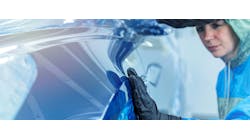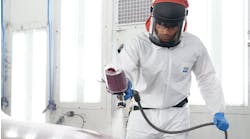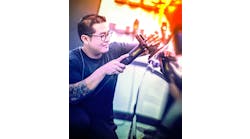Is color tinting really necessary for this job? The larger issue might be: How can that question be answered at estimate time before it becomes an issue?
The basic answer is experience. An experienced painter will know which colors cause more trouble. An experienced estimator also will know.
Tinting is re-mixing the color to attain a blendable match. Blending is the panel spraying process. The most experienced painter using the highest quality materials and the best mixing equipment may not produce a blendable match with the initial color mix. This makes color tinting a requirement.
Color match difficulties aren't going to show up fully until the painting is complete. At that point, any additional costs involved in tinting have to be recovered in a supplement. Documenting your color tinting effort is not simple. Before-and-after photos don't show the process. The additional spray-out sheets or photos of them might suffice in some cases.
Estimating systems provide some general support by showing what is and what isn't included in these refinish labor amounts. Audatex currently has the most detailed definition and explanation for how labor is calculated.
Audatex's two-stage setup refinish labor includes time for standard tint, with standard tint defined as the initial mix, check, one tint cycle and check. Audatex's studies show instances where additional time is required for the tinting process. This time commonly ranges between 0.1 and 1.0 hours, with an average of 0.5 hours per estimate per color.
Audatex notes that the appearance of color match can be so difficult as to require both color tint (tinting to adjust the color) and blending. The company notes that I-CAR Finish Matching (Module 2, Topic 3) recommends planning and preparing for blending before the work begins. I-CAR also recommends that tinting should be done only to achieve a blendable match.
Included in Audatex's two-stage refinish operations are:
- Mix color, spray test panel, compare to vehicle
- Initial tint, spray test panel, let down, compare to vehicle
Not included in Audatex two-stage refinish operations are:
- Spray additional test panel
- Blending into adjacent panels
- Tint primer or clear coat
MOTOR (CCC) does not include:
- Blending into adjacent panels
- Color matching to adjacent panels
- Test spray-out panel
- Tinting primer-sealer
- Tinting to achieve color match
Mitchell lists in its Not Included Operations for refinish:
- Blending into adjacent panel and/or panels, or nearest breaking point
- Color match or tinting
Mitchell notes: "It may be necessary to tint or otherwise modify non-exterior colors applied to undersides, edges and/or jambs for which there is no paint color formula to achieve a color match. When necessary, reference 'color match or tinting' listed above in Not Included Operations."
Is color tinting really necessary? It may be. During your estimating or supplement process, consider the need to along with the additional costs of tinting paints for color coats, undercoats and undersides according to the estimating system being used for the repair.
In the end, the most important thing is the appearance of a perfect color match, which consistently is a major concern for vehicle owners. Tinting may be necessary to get there. With either an initial estimate or final supplement line for tinting labor and materials, you need to make sure you are properly compensated. Without at least recovering your costs, you can't maintain a healthy business and, therefore, perform quality work.



